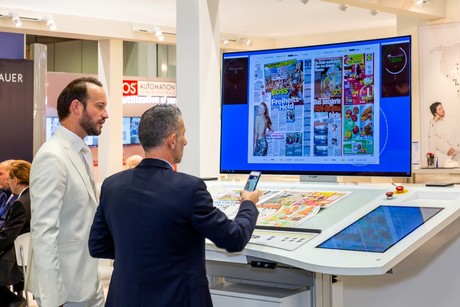In recent years, digital printing, especially inkjet printing, has made major progress in all the areas important to newspapers (format, speed, quality, etc.). While the offset process has long since reached the stage of optimum development, digital printing is still far from attaining its development potential.
But that does not mean it’s advisable to sit back and await further developments, because the process currently offers newspapers a wide range of applications:
- Already well-established is the production of newspapers on-site at popular holiday resorts instead of shipping copies to the readers there.
- A similar application is the production of newspapers in capital or major cities, an offer for national and regional newspapers that want to have a presence there.
- The production of special editions for specific occasions (such as events) could be termed “event printing.”
- A new application that has recently become technically feasible is short-run printing. With the appropriate job structure, it can represent a more efficient alternative to offset for the newspaper printing plant.
- The printing of special supplements enables the tailoring of newspaper sections to suit the requirements of specific groups of readers, defined geographically or by their particular interests. The supplements are combined with the main product in the mailroom.
- ”Personalisation printing” has two basic forms:
1. Imprinting of individualised characteristics: e.g. lottery ticket number, personal access code, etc. (in hybrid printing: offset plus continuous inkjet)
2. Printing of variable data for certain narrowly defined audiences (in hybrid or purely inkjet printing); theoretically also for specific individuals – though newspapers do not yet have the necessary means to make the reader data available.
- For the sake of completeness, mention should be made of two print-on-demand models:
1. Just-in-time printing at vending machines, though this is likely to remain a niche application or vanish entirely as a result of the increasing presence of mobile electronic media.
2. The personal newspaper, which is assembled according to each individual reader’s personal interest profile. The contents are drawn from various news sources. All attempts to date to create a working business model on this basis have failed, however. Here as well, the mobile internet is the biggest competitor.
New SFN Report available now
WAN-IFRA has published a new SFN Report titled “Digital printing for newspapers.” The report investigates the business case for digital printing, the current use of digital printing in newspaper production, and the latest case studies in the USA, Italy and Germany.
For WAN-IFRA members the SFN Report is available free of charge; for non-members the price is 150 Euros: http://www.wan-ifra.org/reports/2013/09/30/digital-printing-for-newspapers
Among the topics are these:
Digital printing as a distribution concept: Distributors were the first to develop a business model exploiting digital printing. The production of foreign newspapers allows distributors to sell copies on the day of publication without expensive air freight costs – an attractive offer.
Earlier this year, IPS Managing Director Dieter Wirtz founded NP Newsprint Berlin as the first location of the IPS subsidiary Newsprint Europe, to which Newsprint Italia, established in 2012, also belongs. If the model is well received, it is planned to open additional digital printing sites and expand Newsprint Europe to an international network for digital newspaper production.
- Short print runs: Many newspaper printing plants are independent businesses that are constantly seeking additional print jobs – but producing small jobs on a large offset press is not cost-efficient. This is where a digital press can demonstrate its potential to the maximum.
The case studies of the printing centres Centro Stampa Quotidiani (CSQ) in Italy and Newsweb in the USA show how digital printing can be used to advantage. Managing Directors Dario de Cian (CSQ) and Rodd Winscott (Newsweb) report on their experiences. In the case of CSQ, this practice helps the newspaper publisher better serve its local markets via digitally printed local sections inserted into the main offset product. In contrast, Newsweb in Chicago uses the inkjet process for its many short print runs as an ideal complement to offset printing – a decision that pays off for the company.
- Hybrid printing: Ink-jet imprinting in offset-produced newspapers is a brilliant idea, since it combines the best of both technologies and opens up entirely new marketing opportunities.
This summer Axel Springer attracted a great deal of attention by installing digital imprinting units on the web presses at all BILD production sites. In an interview, project manager Tobias Kuhn describes the project and the company’s plans to use the new technology in applications other than contests.
- Some basic facts about digital printing: It is a newcomer to the newspaper sector and some things – indeed, nearly everything – are totally different from offset. This chapter provides basic information about the technology and cost structure of digital printing.
- What the suppliers say: Suppliers of inkjet printing solutions present their philosophies as well as their views on the future prospects for the newspaper sector.
- Overview of the most important inkjet web systems for newspaper printing and their basic parameters.



